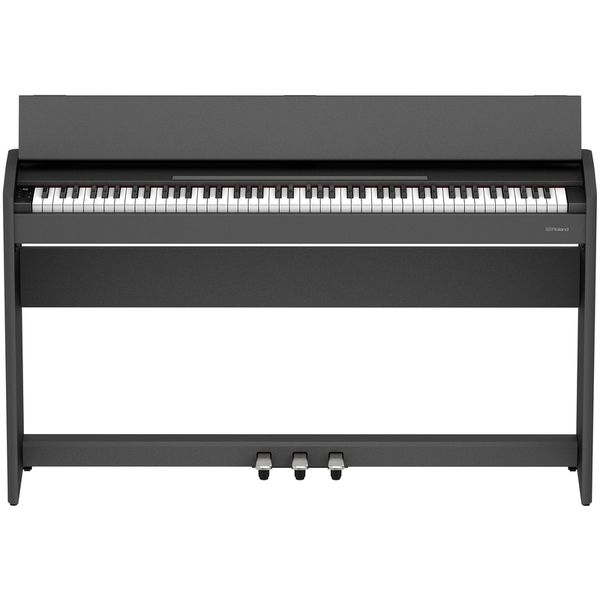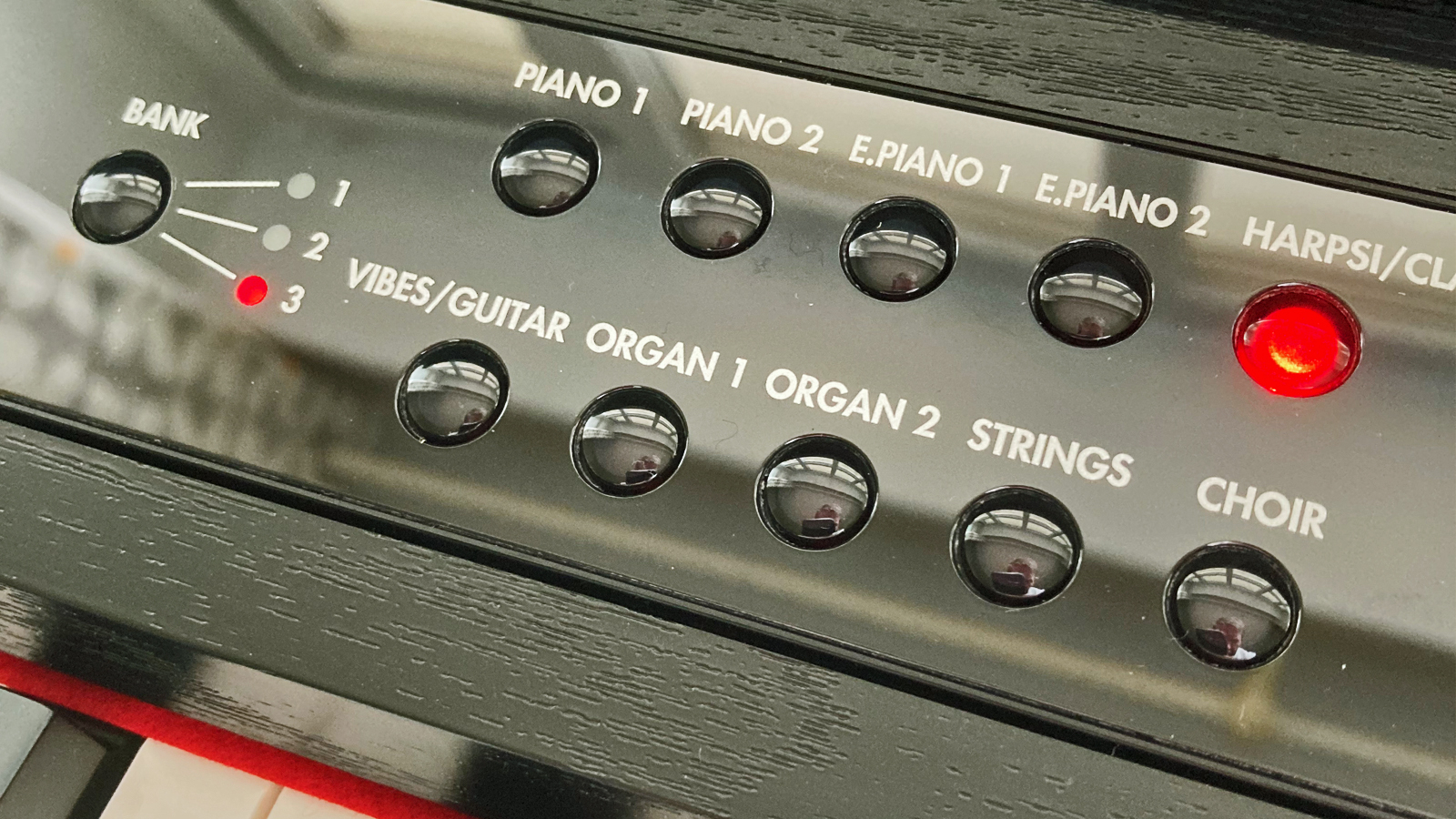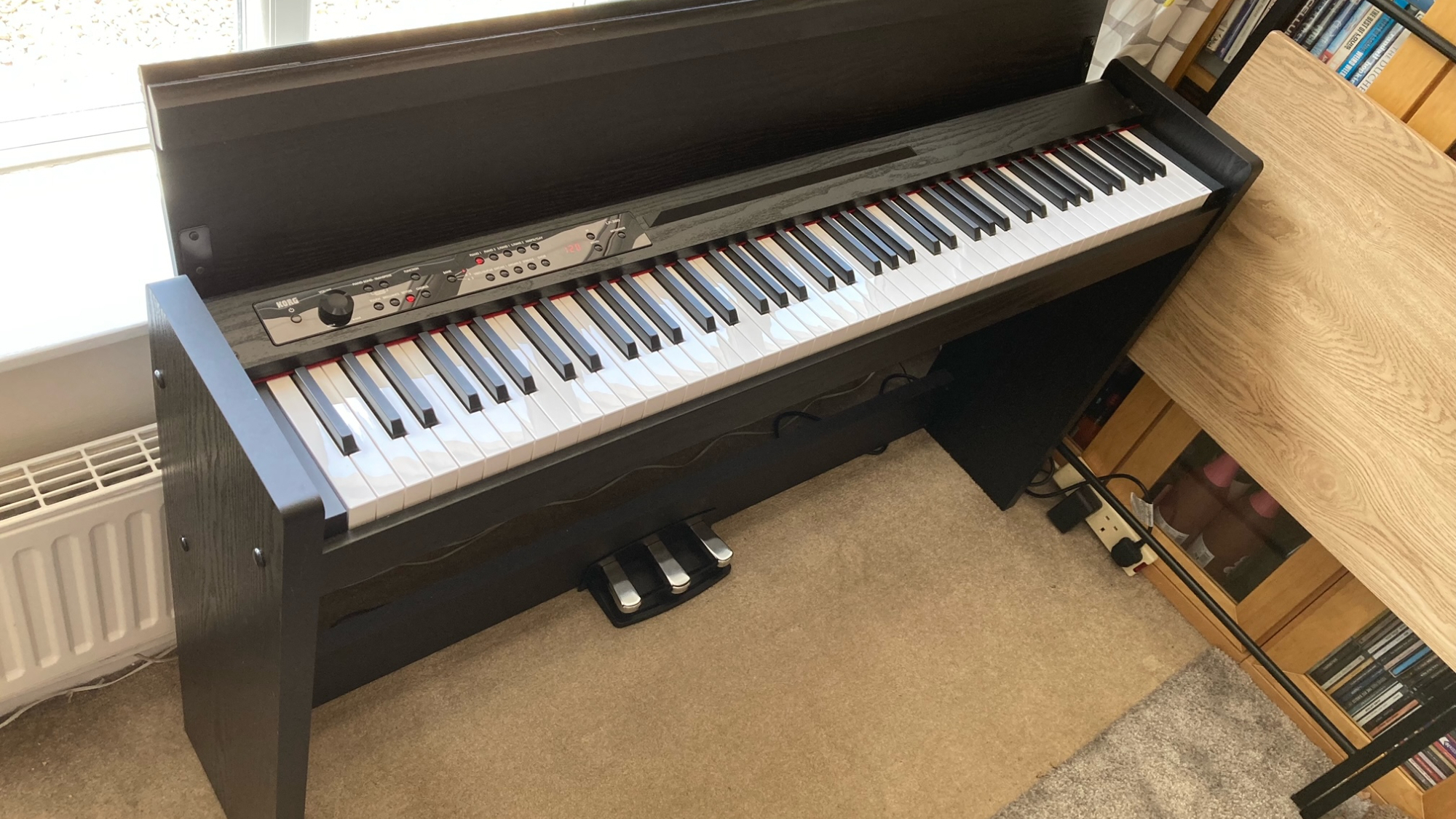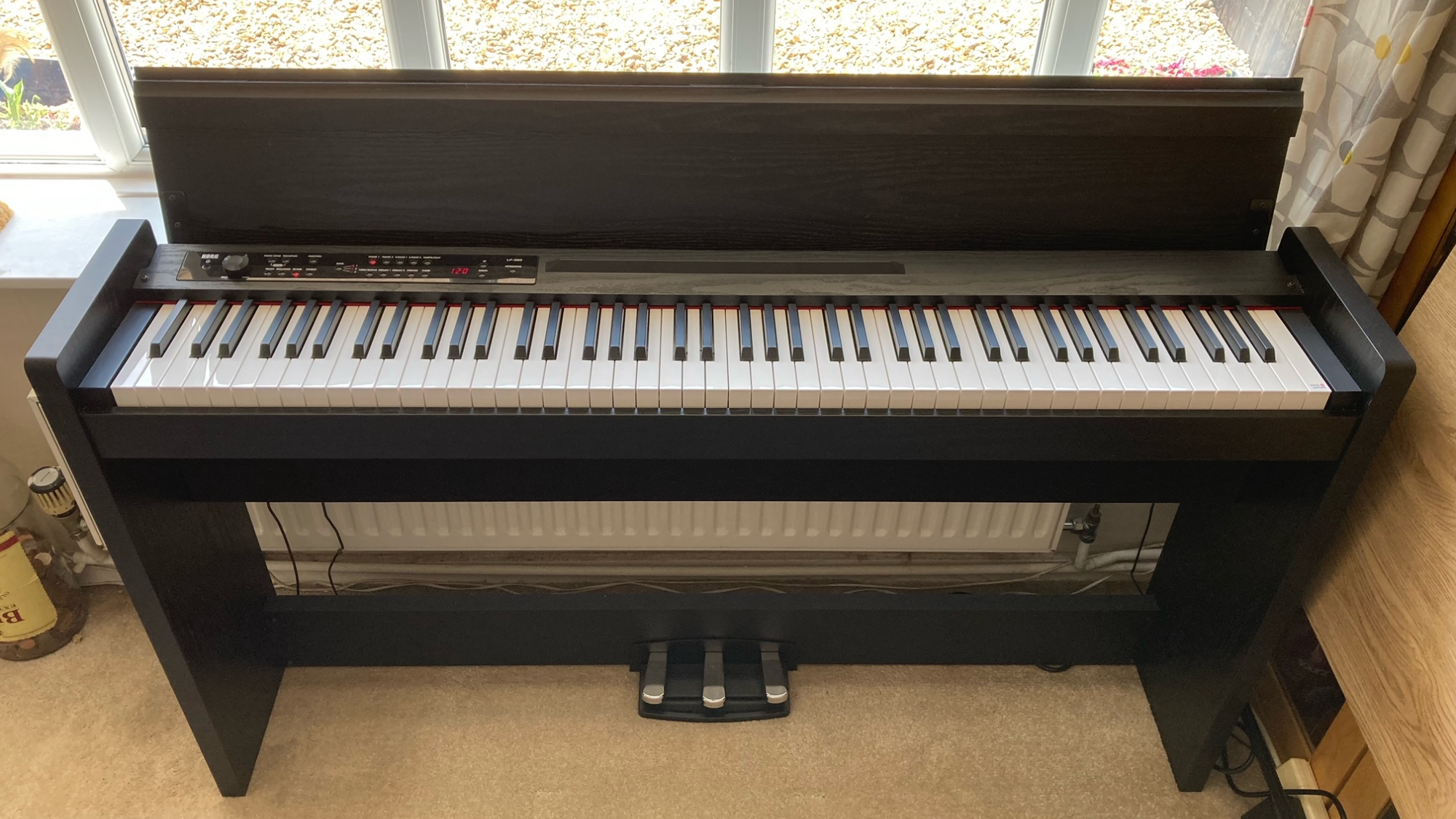MusicRadar Verdict
All in all, the LP-380’s simplicity and ease of use is impressive. It appears to be an effective compromise between affordability, sound quality and depth of features. If all you need is an affordable, no-frills digital piano for the home that you can just switch on, set the volume and play without fuss, and that won’t take up too much space in your living room, the LP-380 more than has you covered, especially if you’re a fan of the Korg piano sound.
Pros
- +
Easy to use
- +
Slim, modern profile
- +
Decent range of instrument tones
- +
Instant on
Cons
- -
Weak harpsichord sound
- -
Limited effects capability
MusicRadar's got your back
Korg LP-380 review: What is it?
Positioned at the more affordable end of the digital console piano market, Korg’s LP-380U pairs the company’s fully-weighted hammer action RH3 keyboard with a selection of 30 onboard sounds. In case you were wondering about that extra ‘U’ in the name, it stands for USB connectivity, which was added to the original LP-380 model in 2021. Aimed at beginners with a sense of style, the LP-380U seeks to focus on great sounds and playability, rather than things like sequencers, song recorders and auto-accompaniment, giving you an instrument that’s extremely approachable and simple to use. Korg are keen to point out that the LP-380U is made in Japan by master craftsmen - and has a sticker on the top ‘C’ key of the keyboard to confirm this.
On delivery, your LP-380U will arrive in a large box and requires self-assembly, but if you know one end of a screwdriver from the other, this should present minimal problems. As a veteran of many Ikea products over the years, it took less than an hour on my own to put the piano together. Once assembled, with the speakers and pedalboard connected, the instrument is remarkably slim - only 261mm front to back - making it a good choice for smaller spaces.
The full-width, soft-close lid doubles as a music desk when raised - the perfect platform for a tablet when learning via an online service or app or using the bundled software. The soft-close lid proved a bit of a misnomer on our test unit though, closing the last few inches with a noticeable clonk. Meanwhile, the hinged lip along the front edge, designed to be folded flat while in use, is a little cumbersome to unfold when you’re ready to close the lid, with no indents or protrusions to grab hold of.
The deep black rosewood grain finish of our review unit’s casing won’t be to everybody’s taste. It gives the instrument something of the appearance of an Argos bookcase with the lid closed, although the finish does seem very hard-wearing and easy to keep clean. If you’re not a fan, you’ll be glad to learn that the LP-380U is also available in gloss white, gloss black and regular rosewood finishes.
Korg LP-380 review: Performance and Verdict

The LP-380 is probably one of the most approachable digital pianos there is in terms of just being able to walk up, switch it on and play with no annoying wait time. In fact, boot time is pretty much zero, taking less than a second to enter a playable state, meaning it’ll be ready and waiting for you as soon as you’ve put your headphones on.
The LP-380’s RH3 keyboard, as found on several of Korg’s other premium weighted-key instruments, such as the SV-2 stage piano and Nautilus workstation, feels as lifelike and responsive as ever to play, with three selectable levels of touch response to choose from. The key tops themselves are smooth and feel a little bit plasticky under the fingers, and I found the key noise a little invasive when playing at moderate volume through the speakers, although obviously, this won’t be a problem if you’re using a set of the best headphones for digital piano.

Roland F107: Roland’s latest slimline home piano uses their renowned SuperNATURAL piano engine and has a similar footprint to the LP-380, with double the polyphony but fewer sounds.
Korg C1 Air: Recent addition to the lineup with a very similar spec to the LP-380 but with a different case design and an onboard two-track song recorder.
Casio PX-770: The PX-770 uses the same advanced AiR Piano sound technology and Tri Sensor II keyboard action as that found in Casio’s flagship Celviano models.
Connections are fairly thin on the ground - there’s a single 3.5mm line output and a USB to host port for hooking the LP-380 up to a computer for use as a MIDI master controller or to a tablet to use with the selection of bundled software. Meanwhile, the two 3.5mm headphone sockets are housed in a small control unit, tucked up under the keys high up on the left-hand side. Bizarrely, this box has a large sticker on the front of it which spoils the look of the instrument somewhat - I found it strange that this isn’t placed out of sight on the rear of the instrument.
Moving on downwards, the twin 10cm speakers are mounted in a sound bar slung beneath the keyboard at knee height. The bundled pedalboard boasts the full complement of three pedals - damper, soft and sostenuto - and the damper pedal supports half-pedalling. The pedals themselves are a smart, modern design in a chrome finish.
The controls are located in a single shiny black panel above the keys on the left-hand side of the keyboard, housing a single large volume control knob, the power on/off button and seven other controls for various functions such as transpose and effects on/off. Further along, we find the ten voice selector buttons and the bank switcher button to switch between the three banks. There’s a 3-digit, 7-segment LED display with two up/down buttons to change value and one final button to enable and disable the metronome.
It’s a simple, well-laid-out interface and possibly one of the easiest to use that we’ve come across. Having the volume control on a large, instantly controllable knob is a bonus, a definite improvement on the up/down volume buttons found on some of this instrument’s peers.
Sounds Abound

The LP-380 offers a selection of 30 onboard sounds divided up into three banks of 10 accessible by the buttons on the front control panel. The usual clutch of acoustic grand piano samples can be found here, five in total ranging from full and rich concert acoustic tones through to honky tonk tack piano, great for blues, ragtime and stride if that’s your thing.
The acoustic piano samples are the usual high-quality tones that we’ve come to expect as standard from Korg, and the third piano in slot 2 is a sort of Yamaha CP80-like electric grand that works pretty well. The E-pianos are excellent, with lots of authentic squeak and clonk in the sounds - the Wurli-esque ’60’s E piano’ in particular proving very enjoyable to play.
Elsewhere, the harpsichord is disappointingly thin-sounding and the clav sounds are also a bit lacking in character, but the vibraphone is suitably warm and soothing, and the guitar is perfectly passable. The six organ sounds run the gamut from jazz Hammond to full-on cathedral pipes, but sadly there's no Leslie effect to be had. The strings are nice, full and cinematic, but offer no arco, staccato or pizzicato samples, and the choir voices are the usual synthetic ooh and aah pads.
All in all a decent range of bread and butter sounds which are perfectly adequate as long as you’re not planning any harpsichord recitals any time soon. You’ll need to remember where your favourites are located though since the LP-380 defaults to the initial grand piano setting every time you turn it off.
Effects wise, you’re limited to Brilliance, Reverb and Chorus, each with its own on/off button and 3-level settings. Some non-acoustic piano sounds have built-in effects that can’t be edited or turned off, which is a bit limiting. For instance, the ’60’s E piano’ sound has a baked-in fast vibrato effect, and the delayed-onset stereo tremolo effect on one of the electric piano sounds was quite startling, particularly when using headphones.
Taking advantage of that added USB port, the LP-380U comes with a decent software bundle, including a trial subscription to the Skoove online piano lesson service, the Korg Module piano keyboard sound module app, and the "Korg Gadget 2 Le" DAW music production app. These can be used to expand the LP-380’s sounds and functionality when used with a smartphone or tablet connected to the USB port with a suitable optional cable.
Verdict

All in all, the LP-380’s simplicity and ease of use is impressive. It appears to be an effective compromise between affordability, sound quality and depth of features. If all you need is an affordable, no-frills digital piano for the home that you can just switch on, set the volume and play without fuss, and that won’t take up too much space in your living room, the LP-380 more than has you covered, especially if you’re a fan of the Korg piano sound.
Korg LP-380 review: Hands-on demos
Jeremy See
Korg
Kraft Music
Korg LP-380 review: Specifications
- Dimensions (W x D x H, mm): 1,355 x 261 x 772 (lid closed), 1,355 x 261 x 936 (lid open)
- Weight: 37㎏
- Keys: 88 full-size, weighted hammer action (RH3) with three levels of touch response
- Polyphony: 120
- Number of Tones: 30
- Speakers: 2 x 22W
- Power Supply: 12V DC
- Connectivity: 2 x 3.5mm headphones jack, 3.5mm stereo audio line output, USB to Host
- Contact: Korg
Dave has been making music with computers since 1988 and his engineering, programming and keyboard-playing has featured on recordings by artists including George Michael, Kylie and Gary Barlow. A music technology writer since 2007, he’s Computer Music’s long-serving songwriting and music theory columnist, iCreate magazine’s resident Logic Pro expert and a regular contributor to MusicRadar and Attack Magazine. He also lectures on synthesis at Leeds Conservatoire of Music and is the author of Avid Pro Tools Basics.
“Excels at unique modulated timbres, atonal drones and microtonal sequences that reinvent themselves each time you dare to touch the synth”: Soma Laboratories Lyra-4 review
“I used everything I knew about music”: How Green Day exceeded expectations with their most ambitious song
YouTube just added AI tools that makes musicians, library music and video editors redundant











